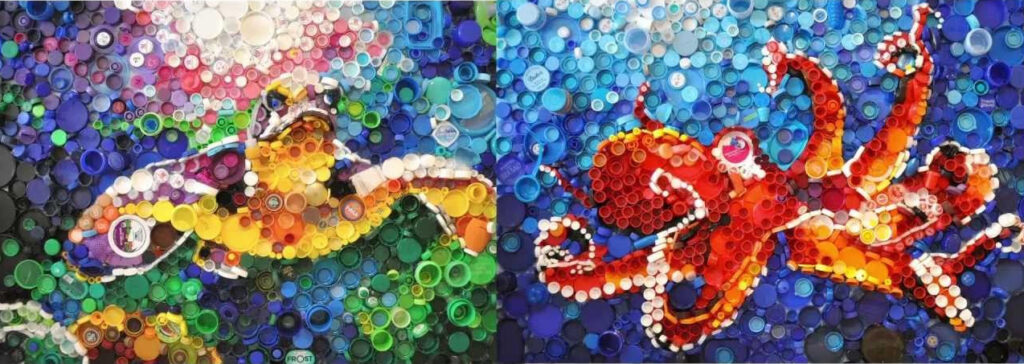Plastic caps can be seen everywhere in our daily lives. However, these small bottle caps are often discarded after use and become part of plastic waste, which eventually affects the environment. In recent years, more and more artists and environmentalists have realized the potential of plastic bottle caps and transformed them into a creative art form-plastic bottle cap art. This art is not only full of creativity, but also shows the possibility of environmental protection, opening up a unique way for the reuse of plastic waste.
History and development of plastic cap art
The origin of plastic cap art can be traced back to the concept of waste utilization. In the early days, people used bottle caps to make simple decorations or handicrafts. However, with the improvement of environmental awareness, bottle cap art has gradually changed from simple waste utilization to a formal art form. Around the world, artists from all over the world convey the concept of protecting the environment to the public by creating plastic bottle cap mosaics, sculptures and interactive installations.
For example, there are community projects in many cities around the world that organize residents to collect bottle caps and use these plastic wastes to create large-scale public art works. These works are not only visually stunning, but also a call for public environmental awareness.

Creative expression: the diverse forms of plastic cap art
Plastic bottle caps are rich in color and shape, providing endless possibilities for artistic creation. Artists use these bottle caps for various creative expressions, common forms include collage, mosaic, sculpture, etc.
- Collage and mosaic art
The rich colors of bottle caps provide natural creative materials for collage and mosaic art. Artists can arrange and combine bottle caps according to color and shape to create lifelike pictures, from landscapes to portraits, bottle caps become a unique “pigment”. Bottle cap mosaic projects around the world show the wide application of this creative method, especially in public places such as schools and community centers. - Sculpture and 3D creation
In addition to two-dimensional art, bottle caps are also used in the creation of three-dimensional sculptures. Artists stack, glue, and even use special connection techniques to create three-dimensional artworks of various shapes. These works not only show the ingenuity of artists, but also make people re-examine the neglected waste in daily life. Large sculpture projects of plastic bottle caps, such as animals, plants and even architectural models, have become a symbol of environmental art. - Interactive art and participatory creation
Plastic cap art is not just a personal creation, it is also a way to promote public participation. In many communities, artists organize bottle cap recycling projects, inviting residents to bring bottle caps used in their lives and collectively create large-scale art installations. This interactive art not only allows the public to understand the importance of plastic recycling, but also enhances the cohesion of the community.
The combination of art and sustainable development
The environmental value of plastic cap art cannot be ignored. Through these works of art, the public can intuitively feel the problem of plastic pollution. This visual impact is more powerful than simple data. Every bottle cap symbolizes the plastic waste generated in our daily life, and through the transformation of art, waste is no longer a source of pollution, but a material for creation.
The future development of plastic cap art
As environmental awareness continues to increase, plastic bottle cap art is also evolving. In the future, this art form will be increasingly combined with sustainable materials and new technologies.
- Combination of sustainable materials and new technologies
The continuous development of recycled plastics and 3D printing technology will provide more creative ways for bottle cap art. Through 3D printing, artists can design more complex and sophisticated works while ensuring higher material utilization in the creation process. In the future, we are expected to see more environmentally friendly works that combine technology and art.
- Education and public participation
Plastic bottle cap art is not only a form of creation, it is also an educational tool. By organizing bottle cap art workshops and community projects, artists can let more people understand the importance of plastic recycling and environmental protection. This direct participation method is particularly suitable for promotion in schools and communities, so that more people can cultivate environmental awareness from an early age.
Conclusion
Plastic cap art is an art form that perfectly combines creativity with environmental protection concepts. Through this art, discarded bottle caps are reborn and become a carrier for conveying environmental protection information. The creation process of each bottle cap is a reflection on plastic pollution and an expectation for sustainable development. We encourage more people to join the ranks of plastic bottle cap art, combine creativity with environmental protection, and create a better future.




